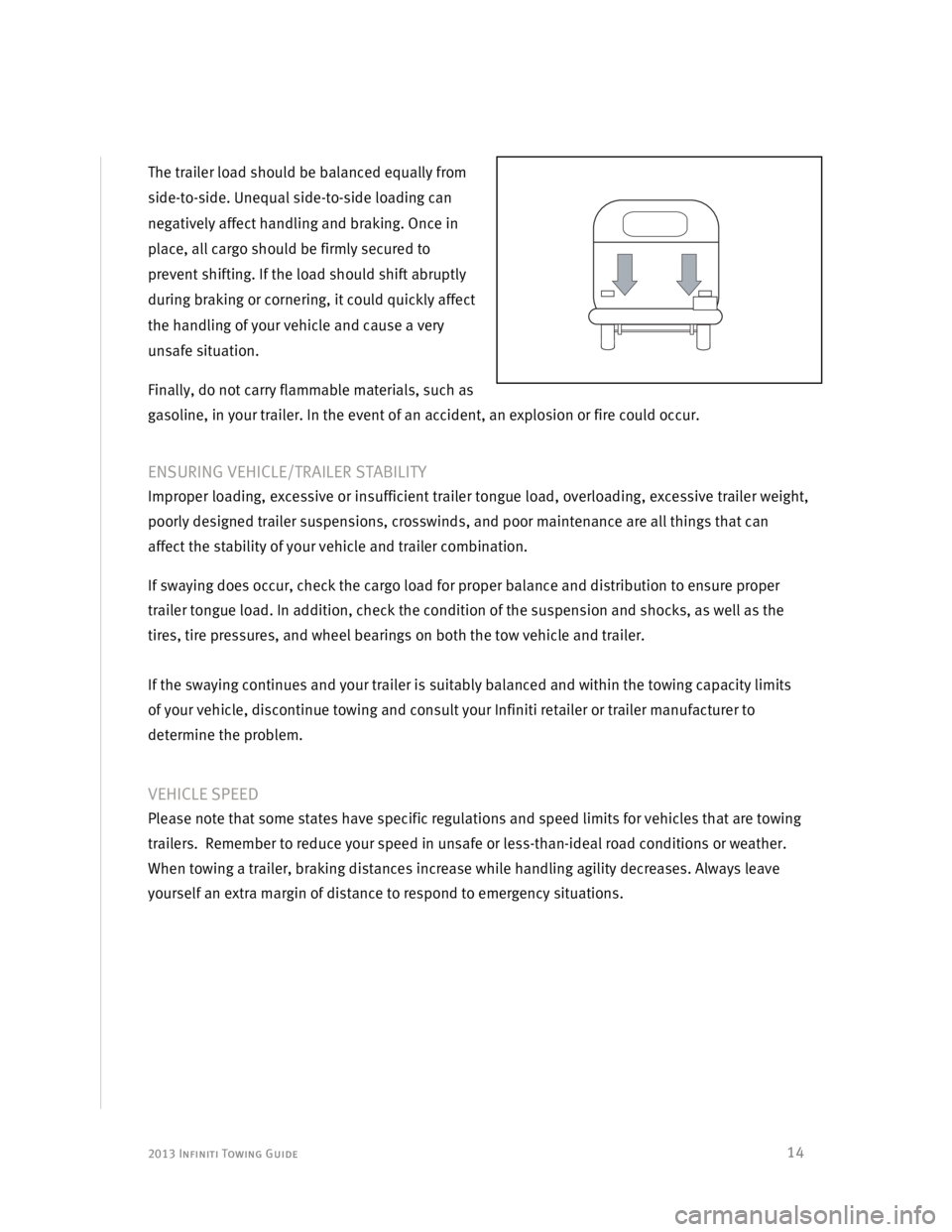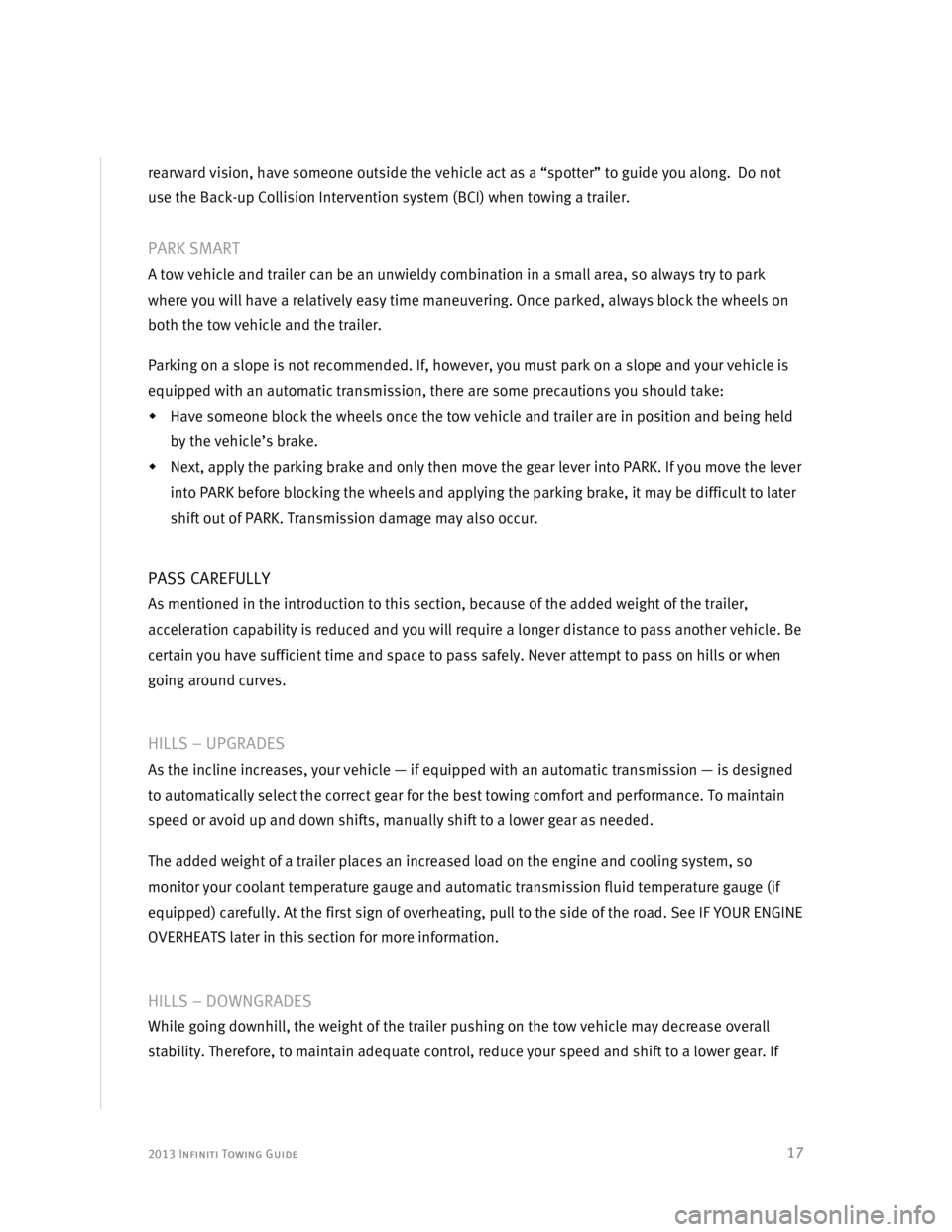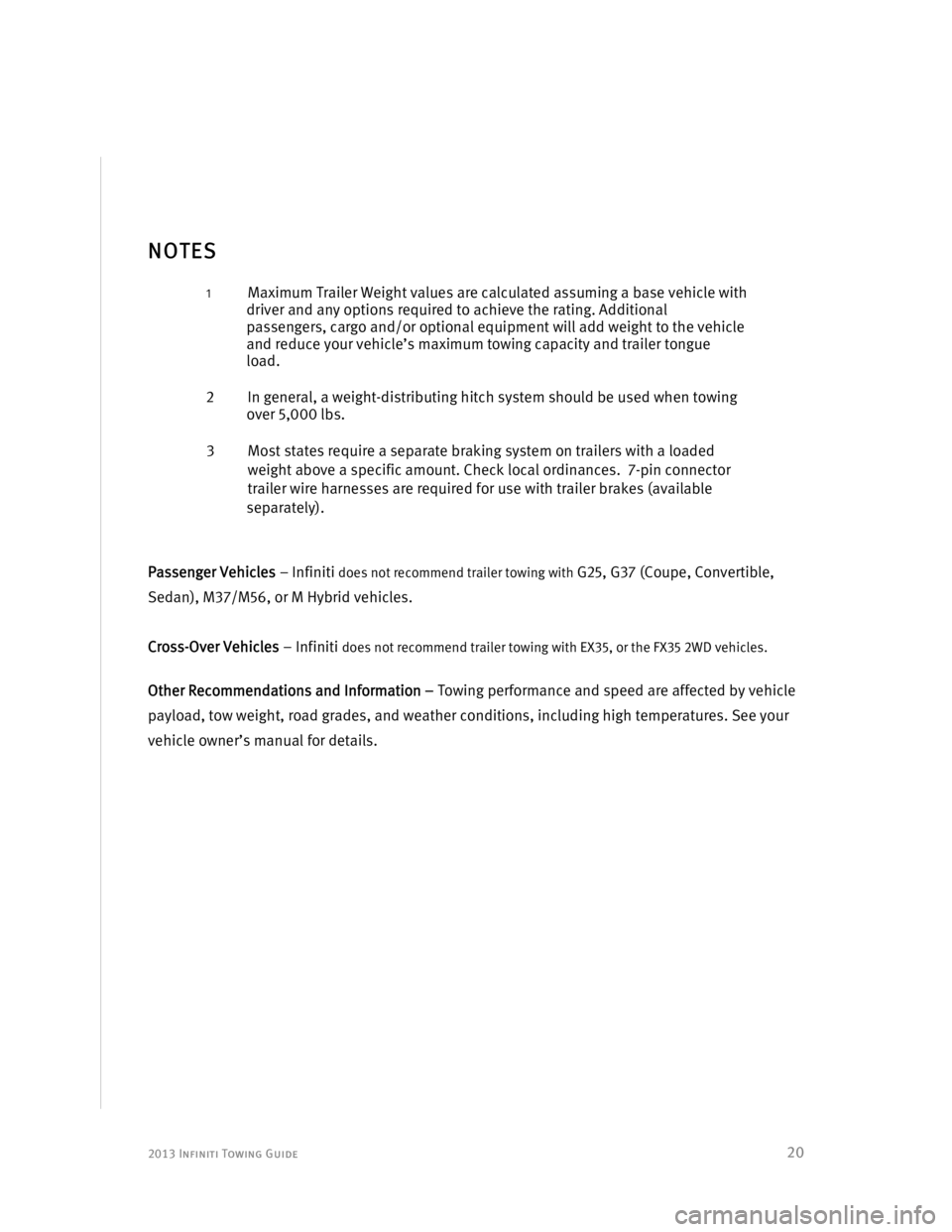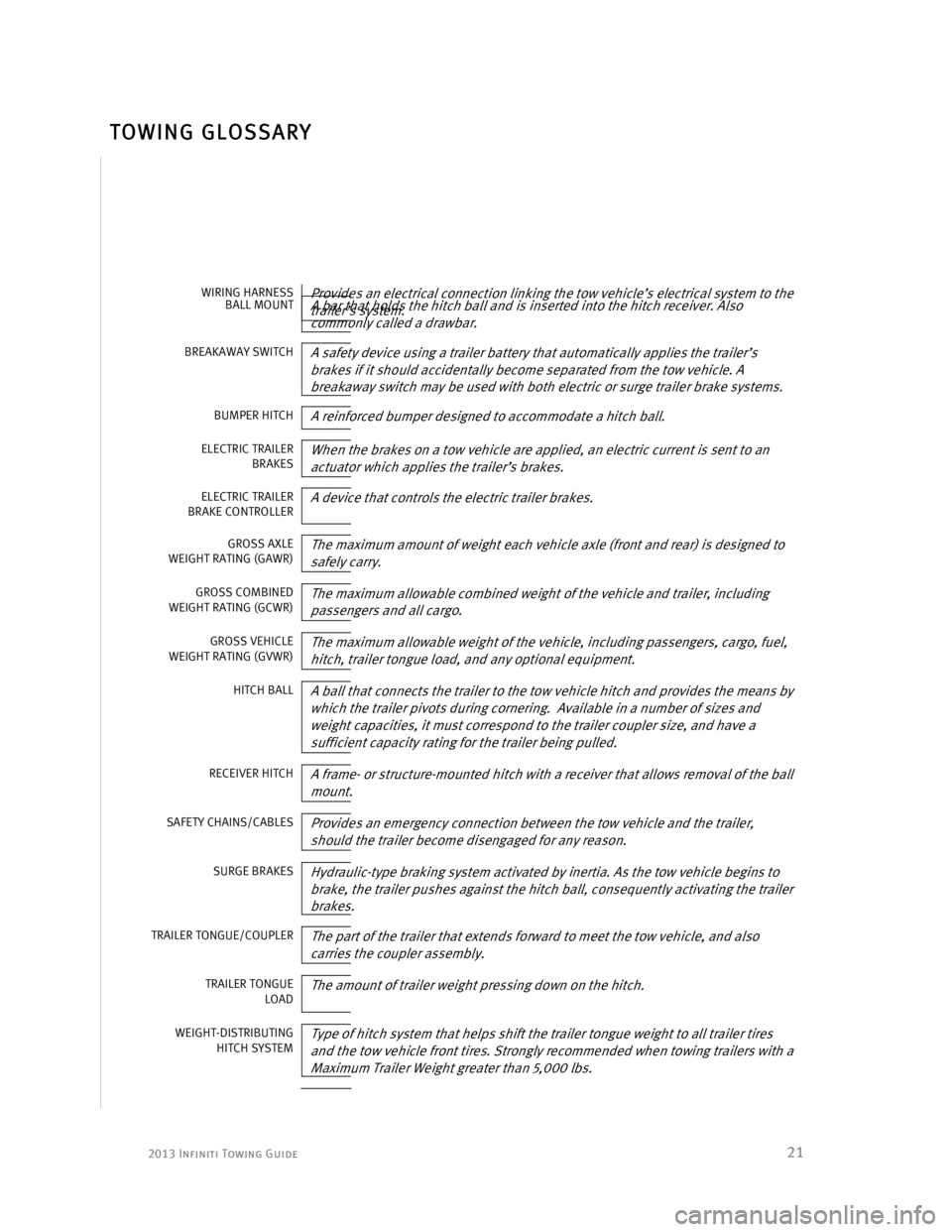weight INFINITI FX 2013 Towing Guide
[x] Cancel search | Manufacturer: INFINITI, Model Year: 2013, Model line: FX, Model: INFINITI FX 2013Pages: 25, PDF Size: 0.42 MB
Page 15 of 25

2013 Infiniti Towing Guide
14
The trailer load should be balanced equally from
side-to-side. Unequal side-to-side loading can
negatively affect handling and braking. Once in
place, all cargo should be firmly secured to
prevent shifting. If the load should shift abruptly
during braking or cornering, it could quickly affect
the handling of your vehicle and cause a very
unsafe situation.
Finally, do not carry flammable materials, such as
gasoline, in your trailer. In the event of an accident, an explosion or fire could occur.
ENSURING VEHICLE/TRAILER STABILITY
Improper loading, excessive or insufficient trailer tongue load, overloading, excessive trailer weight,
poorly designed trailer suspensions, crosswinds, and poor maintenance are all things that can
affect the stability of your vehicle and trailer combination.
If swaying does occur, check the cargo load for proper balance and distribution to ensure proper
trailer tongue load. In addition, check the condition of the suspension and shocks, as well as the
tires, tire pressures, and wheel bearings on both the tow vehicle and trailer.
If the swaying continues and your trailer is suitably balanced and within the towing capacity limits
of your vehicle, discontinue towing and consult your Infiniti retailer or trailer manufacturer to
determine the problem.
VEHICLE SPEED
Please note that some states have specific regulations and speed limits for vehicles that are towing
trailers. Remember to reduce your speed in unsafe or less-than-ideal road conditions or weather.
When towing a trailer, braking distances increase while handling agility decreases. Always leave
yourself an extra margin of distance to respond to emergency situations.
Page 18 of 25

2013 Infiniti Towing Guide
17
rearward vision, have someone outside the vehicle act as a “spotter” to guide you along. Do not
use the Back-up Collision Intervention system (BCI) when towing a trailer.
PARK SMART
A tow vehicle and trailer can be an unwieldy combination in a small area, so always try to park
where you will have a relatively easy time maneuvering. Once parked, always block the wheels on
both the tow vehicle and the trailer.
Parking on a slope is not recommended. If, however, you must park on a slope and your vehicle is
equipped with an automatic transmission, there are some precautions you should take:
�Š Have someone block the wheels once the tow vehicle and trailer are in position and being held
by the vehicle’s brake.
�Š Next, apply the parking brake and only then move the gear lever into PARK. If you move the lever
into PARK before blocking the wheels and applying the parking brake, it may be difficult to later
shift out of PARK. Transmission damage may also occur.
PASS CAREFULLY
As mentioned in the introduction to this section, because of the added weight of the trailer,
acceleration capability is reduced and you will require a longer distance to pass another vehicle. Be
certain you have sufficient time and space to pass safely. Never attempt to pass on hills or when
going around curves.
HILLS – UPGRADES
As the incline increases, your vehicle — if equipped with an automatic transmission — is designed
to automatically select the correct gear for the best towing comfort and performance. To maintain
speed or avoid up and down shifts, manually shift to a lower gear as needed.
The added weight of a trailer places an increased load on the engine and cooling system, so
monitor your coolant temperature gauge and automatic transmission fluid temperature gauge (if
equipped) carefully. At the first sign of overheating, pull to the side of the road. See IF YOUR ENGINE
OVERHEATS later in this section for more information.
HILLS – DOWNGRADES
While going downhill, the weight of the trailer pushing on the tow vehicle may decrease overall
stability. Therefore, to maintain adequate control, reduce your speed and shift to a lower gear. If
Page 21 of 25

2013 Infiniti Towing Guide
20
NOTES
Passenger Vehicles – Infiniti
does not recommend trailer towing with G25, G37 (Coupe, Convertible,
Sedan), M37/M56, or M Hybrid vehicles.
Cross-Over Vehicles – Infiniti
does not recommend trailer towing with EX35, or the FX35 2WD vehicles.
Other Recommendations and Information – Towing performance and speed are affected by vehicle
payload, tow weight, road grades, and weather conditions, including high temperatures. See your
vehicle owner’s manual for details.
1 Maximum Trailer Weight values are calculated assuming a base vehicle with
driver and any options required to achieve the rating. Additional
passengers, cargo and/or optional equipment will add weight to the vehicle
and reduce your vehicle’s maximum towing capacity and trailer tongue
load.
2 In general, a weight-distributing hitch system should be used when towing
over 5,000 lbs.
3 Most states require a separate braking system on trailers with a loaded
weight above a specific amount. Check local ordinances. 7-pin connector
trailer wire harnesses are required for use with trailer brakes (available
separately).
Page 22 of 25

2013 Infiniti Towing Guide
21
BALL MOUNT A bar that holds the hitch ball and is inserted into the hitch receiver. Also
commonly called a drawbar.
BREAKAWAY SWITCH A safety device using a trailer battery that automatically applies the trailer’s
brakes if it should accidentally become separated from the tow vehicle. A
breakaway switch may be used with both electric or surge trailer brake systems.
BUMPER HITCH A reinforced bumper designed to accommodate a hitch ball.
ELECTRIC TRAILER BRAKES When the brakes on a tow vehicle are applied, an electric current is sent to an
actuator which applies the trailer’s brakes.
ELECTRIC TRAILER BRAKE CONTROLLER A device that controls the electric trailer brakes.
GROSS AXLE WEIGHT RATING (GAWR) The maximum amount of weight each vehicle axle (front and rear) is designed to
safely carry.
GROSS COMBINED WEIGHT RATING (GCWR) The maximum allowable combined weight of the vehicle and trailer, including
passengers and all cargo.
GROSS VEHICLE
WEIGHT RATING (GVWR) The maximum allowable weight of the vehicle, including passengers, cargo, fuel,
hitch, trailer tongue load, and any optional equipment.
HITCH BALL
A ball that connects the trailer to the tow vehicle hitch and provides the means by
which the trailer pivots during cornering. Available in a number of sizes and
weight capacities, it must correspond to the trailer coupler size, and have a
sufficient capacity rating for the trailer being pulled.
RECEIVER HITCH A frame- or structure-mounted hitch with a receiver that allows removal of the ball
mount.
SAFETY CHAINS/CABLES Provides an emergency connection between the tow vehicle and the trailer,
should the trailer become disengaged for any reason.
SURGE BRAKES
Hydraulic-type braking system activated by inertia. As the tow vehicle begins to
brake, the trailer pushes against the hitch ball, consequently activating the trailer
brakes.
TRAILER TONGUE/COUPLER The part of the trailer that extends forward to meet the tow vehicle, and also
carries the coupler assembly.
TRAILER TONGUE
LOAD The amount of trailer weight pressing down on the hitch.
WEIGHT-DISTRIBUTING
HITCH SYSTEM Type of hitch system that helps shift the trailer tongue weight to all trailer tires
and the tow vehicle front tires. Strongly recommended when towing trailers with a
Maximum Trailer Weight greater than 5,000 lbs.
WIRING HARNESS
Provides an electrical connection linking the tow vehicle’s electrical system to the
trailer’s system.
TOWING GLOSSARY